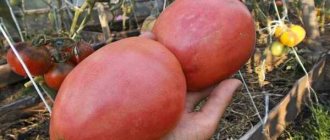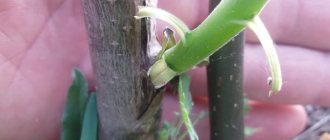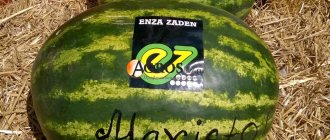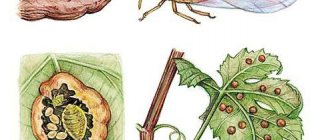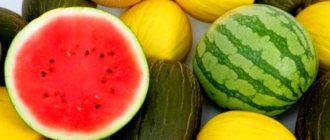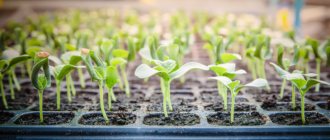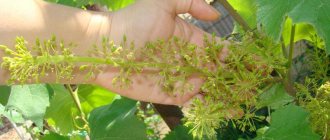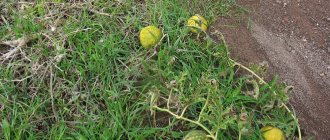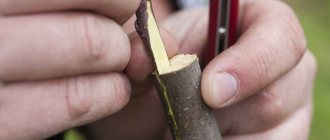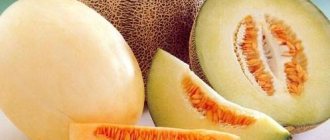Watermelon is a heat-loving plant. For normal growth and ripening of berries, warm air and soil are required, as well as sunlight. The climatic conditions of the middle regions are not suitable for the classical technique of cultivating melons. But there is a way that allows you to grow a bush with a unique taste - grafting a watermelon onto lagenaria.
Why is watermelon grafting needed?
The reason that led to the decision to combine these crops was the weak and too sensitive root system of the watermelon. She is uncomfortable at a temperature of +18°C. Pumpkin is more stable and hardy in cool weather; even at a temperature of +7°C its roots continue to receive nutrition from the soil.
The main advantages of grafting watermelon onto pumpkin:
- resistance to negative environmental factors increases;
- the effect of pathogens that cause crop diseases (fusarium, anthracnose, fungal root rot) is reduced or completely absent;
- the growing season, the rate of development and the ripening time of watermelon increase;
- the number of ovaries and productivity increases;
- it becomes possible to sow early in open ground;
- the need for moisture, heat and soil composition is reduced;
- there is no crop rotation;
- drought resistance appears.
Main disadvantages:
- Not all varieties of pumpkins are suitable;
- Maximum caution is required when grafting;
- fragility of young plants.
How did watermelons and melons grow on lagenaria?
Overall, I was pleased with the results of the vaccinations. Both watermelons and melons grafted onto lagenaria eventually received almost all the benefits described by the founders of this method. The plants grew really well. Despite the weather conditions, they did not suffer from any illness and produced quite large and quite sweet (even taking into account the cool summer) fruits.
The only thing I didn’t notice in my conditions was a particular increase in yield. From each bush I managed to collect only one watermelon and 2-3 melons.
The care required for grafted melons was the same as for regular ones - planting in prepared fertile soil, fertilizing and watering during drought. The only difference is that the plants still needed more monitoring, since in the open ground lagenaria does not resign itself to the role of a rootstock and every now and then begins to grow vigorously.
On one bush, I did not have time to tame the pumpkin in time, and it turned into a full-fledged bush, completely drowning out the watermelon scion, which was represented by only two leaves, and, of course, did not produce any fruit.
However, if you regularly monitor the plants, taming lagenaria is not difficult, and the results are worth it. Therefore, I plan to repeat my experiments with grafted melons in the next season. And I recommend you try it!
What you will need
Prepare for the procedure:
- for cutting: blade, scalpel, sharp knife;
- for dressing: polyethylene strapping tape, thread, bandage, aluminum foil, polyethylene strips;
- special grafting clips or clothespins with a smooth clamping surface;
- for tying: sticks or pegs according to the size of the seedlings.
Tools must be sharp so as not to crush the cells, and clean to prevent the entry of bacteria and dirt. The contact during the cut should be tight, well pressed and securely fixed with a clip.
Reference. A large supply of plants should be grafted, since only a small part of the watermelon survives.
Lateral incision grafting method
You can quite easily graft a watermelon into a side cut on the pumpkin stem yourself. When the lagenaria sprout already has at least 1 true leaf, and the kavuna seedling has 1–2 leaves, the plants can be grafted. Using a sharp knife blade, make a vertical cut approximately 1.4 - 2.0 cm long on the pumpkin stem below the cotyledon leaves. Using the same sharp blade, cut off the watermelon top at an acute angle below the cotyledon leaves.
The cut top of the watermelon is inserted into a vertical cut on the watermelon stem, so that the cut surfaces of the two plants are in close contact. The grafting site is secured with a grafting clip for several days.
Important! Do not remove the grafting clip before the prescribed time. This can lead to disruption of the fusion of the scion and rootstock.
A greenhouse effect is created for the plant by cutting off one side of a plastic bottle or plastic bag for the period of overgrowing of the cuts. Approximately 10 days after a successfully completed grafting, the top of the lagenaria is cut off, leaving an established watermelon sprout. This results in a new plant with watermelon tops and a powerful pumpkin root system, capable of actively taking moisture and all the necessary nutrients from the soil even at low ambient temperatures. The roots of an ordinary watermelon, which is accustomed to growing in well-warmed, light soils, do not have such features.
Which pumpkin is best to graft on?
Decorative lagenaria is well suited for grafting watermelons. Many years of grafting on pumpkins have proven that it is lagenaria (ornamental squash from the pumpkin family) that is in great demand and has the necessary properties for grafting watermelons.
The best varieties of watermelon are:
- Chill;
- Astrakhan;
- Chernouska;
- Kherson;
- Korean.
The main advantages of using lagenaria:
- high compatibility of cultures, which helps the grafting take root;
- powerful root system;
- high survival rate even in cold regions;
- increased resistance to watermelon diseases.
It is also possible to graft watermelon onto figoleaf pumpkin and squash. These methods are used less frequently, since their effectiveness is less than that of Lagenaria vaccinations.
Why lagenaria?
Theoretically, you can graft a melon or watermelon onto any member of the pumpkin family - be it a pumpkin or a zucchini. However, it has been experimentally found that bottle gourd has the highest compatibility with scion in the form of watermelons and melons, which leads to the best results. In particular, such vaccinations take root easily. Lagenaria has a very powerful root system that provides nutrition to the entire plant and its fruits, excellent cold resistance and disease resistance.
Lagenaria is often grown as an independent crop; its other names are gourd, bottle gourd or dish gourd. As you can guess from the name, the main purpose of this pumpkin is to create decorative dishes (jugs, vases, etc.). Thanks to its ability to retain its shape and be processed, it is highly valued by craftsmen.
At the same time, the high cold resistance of the root system made this pumpkin ideal for growing with melons and watermelons. Lagenaria develops well even when the soil temperature is only +5 degrees, while watermelon needs at least +15, and at lower temperatures it simply stops growing.
What other benefits do watermelons and melons have on bottle gourd roots?
- According to the observations of many gardeners, the yield of grafted watermelons and melons approximately doubles.
- Due to the increase in the amount of sugars due to the powerful root of lagenaria, which nourishes the fruits, the taste of the crop also improves.
- Grafted plants have earlier ripening periods and fruits can be harvested on average 10–15 days earlier, compared to ungrafted specimens of similar varieties.
- Watermelons and melons grafted onto lagenaria are not susceptible to fusarium wilt, since the root system of bottle gourd is resistant to this insidious disease, which can destroy the plant completely.
Lagenaria strives for active growth, it is important to remove pumpkin foliage in a timely manner.
How will pumpkin affect watermelon?
Effect of pumpkin rootstock on watermelon:
| Taste | Doesn't change. |
| Nutrition | More nutrients and moisture are supplied. |
| Survival | Resistance to unfavorable environments and endurance increases as the soil temperature decreases. |
| Fruit | The taste improves, they become more sugary, the number of fruits and their volume increases. |
Some rules for grafting melons or how to graft a watermelon onto a pumpkin
Modern melon growing is increasingly abandoning the use of chemicals and labor-intensive technologies to stimulate the growth and fruiting of melons in unsuitable climatic conditions. Grafting or artificial merging of two related crops, when the powerful root system of a stronger plant feeds the grafted stem of a less resistant plant, is what replaces traditional growing technologies with great success. As an example, watermelons are grafted onto a pumpkin, and the heat-loving berry receives continuous nutrition from the soil even when its temperature drops to 7°C. The grafting technique for propagating melons is used in many countries; in some, such as Japan, France, South Korea, etc., all growing melons are grafted.
How to graft a watermelon onto a pumpkin
There are many methods of vaccination:
- tongue;
- to the center (to the cleft);
- rapprochement;
- end-to-end;
- injected;
- in a side section;
- into the phone.
Tongue
This is the most commonly used method. It gives good survival rate due to the large contact between the scion and the rootstock and the presence of roots in both pumpkin and watermelon.
Watermelon is planted three days earlier. The seeds are germinated in advance. You can sow them in one container or in different ones.
For grafting, a cut is made in the middle between the root and the leaves on the rootstock (from top to bottom) and on the scion (from bottom to top). The depth of the cut should be 1-1.2 cm to the middle of the stem. Tabs are formed that connect and secure. The grafted plant must be tied to a stake.
After five days, the plants grow together. It is necessary to crush the lower part of the watermelon so that its roots die off and it switches to nutrition from the roots of the rootstock.
Pumpkin leaves are removed during watermelon growth so that three “native” leaves remain (two cotyledons and one true).
By rapprochement
The only difference is the connection method. The skin layer of the seedlings is cut off, after which they are connected and fixed for fusion. Other actions are repeated as when grafting with a tongue.
Copulation
Copulation is similar to butt grafting. The main difference is the volume of the rootstock. The pumpkin must be planted at the same time as the watermelon so that its stem is stronger and thicker.
Next, the growing point is removed, leaving one cotyledon leaf. A cut is made on the rootstock from the removed leaf parallel to the stem, 7-8 mm long. The scion is cut in the middle of the stem and connected to the plant. Afterwards everything is secured with a clip or tape.
Lateral incision grafting
The survival rate with this method is considered high, but not everyone knows about the possibility of using it to graft watermelon.
It is similar to tongue grafting, only the root system of the watermelon is removed immediately. The pumpkin stem is cut to the center with an oblique line, the watermelon stem is cut through with an oblique cut, leaving only a thin layer of skin on the other side. Afterwards, the seedling is inserted into the cut on the pumpkin stem and fixed.
Vaccination in the center (injection)
Fast, simple and effective way.
The pumpkin must be sown earlier to obtain a thick and strong stem by the time of grafting. Before grafting, the growing point is removed. The center of the stem is pierced with a toothpick or a sharp stick to a depth of 5 mm. The stick or toothpick remains in place until grafting. A watermelon 3-4 days old is cut diagonally and inserted into the puncture site. Fixation is not required, as the scion holds on its own.
There are general recommendations for watermelon grafting:
- sterility: instruments and hands must be treated with alcohol;
- grafting is carried out in the evening or cloudy times;
- containers for pumpkins should be larger;
- the day before grafting, water the rootstock with a sufficient amount of water;
- for plants to grow together, it is necessary to maintain high humidity (70%) in the place where they are placed;
- protect from direct sunlight;
- t +25…+28°C.
My experience of grafting watermelons and melons onto lagenaria
There are several methods of grafting watermelons and melons onto lagenaria: with a tongue (at the joint), in a split, by approaching and some others.
Of all the possible options, I decided to practice with two: grafting with the tongue and by approaching. Both methods are characterized by high survival rate, since at first the root is preserved on both plants and there is a significant area of contact between the rootstock and scion.
Preparation begins with sowing the seeds. Based on the fact that when planting in the ground, the age of melon seedlings should be about 25 days (older seedlings take root worse), I started sowing seeds for seedlings on the 20th of April. First, I sowed the hatched watermelon seeds in a P9 glass. Three days later, I sowed the sprouted lagenaria seeds into the same cups.
Tongue grafting
After both plants have formed one true leaf, you can proceed directly to grafting. First of all, the plants are watered abundantly, after which I manually plucked out the growing points of the pumpkin seedlings. Next, using a sharp blade wiped with alcohol, I made a shallow oblique cut from top to bottom in the middle of the stem of the pumpkin seedling, after which I carried out a similar operation on the scion, making the cut from bottom to top.
Thus, small tongues formed on the watermelon and lagenaria seedlings, which must be carefully aligned. Next, you need to fix the grafting site; for this I used special clip-on clothespins, which are sold in garden stores. But you can also use duct tape or foil. For better stability, grafted seedlings were tied to bamboo sticks (skewers, skewers), which can be easily found for sale in supermarkets.
The rootstock leaves only two cotyledons and a single leaf; the watermelon scion has a well-developed lash.
Caring for seedlings after grafting
After grafting, the seedlings must be kept in shade for the first time at high air humidity. As an improvised greenhouse, I used a plastic container, which is usually used for storing children's toys and other things. Such a container seemed like an ideal solution, since it is quite spacious, since pots with grafted plants take up a lot of space. And it is quite tall, which is important for powerful melon seedlings.
The container with the seedlings was on the floor away from the window; no additional shading was required for the plants. About once a day I opened the lid of the greenhouse and wiped the condensation from the walls, leaving it open for a few minutes to ventilate. Then she closed it tightly again.
On average, seedlings are kept in such conditions for 5-7 days. You can determine that the operation was successful by good foliage turgor. The survival rate of the scion turned out to be quite high and out of 10 grafted seedlings I lost only one.
The next stage after we took the seedlings out of the greenhouse and put them on the window is to separate the watermelon seedlings from their own roots. To do this, I simply crushed the watermelon stem below the graft with my fingers, but the stem was not completely separated, but only slightly damaged.
In order for complete survival to occur as gently as possible, the stem of the watermelon had to be kneaded several times, after which the stem completely dried out and could be cut off.
During the growth of grafted seedlings, the pumpkin scion constantly tries to take its toll and begins to grow rapidly, so it was necessary to constantly remove the leaves that were formed on the lagenaria, leaving only two cotyledons and one true one.
Vaccination by rapprochement
Approximation grafting is almost identical to the tongue fusion method. But the technique for performing it seemed simpler to me, since the incision is not made obliquely, but is made evenly. For grafting by splicing, the skin of the rootstock and scion is cut to a depth of 2 millimeters at the same level, after which the plants are also fixed with a clip.
I’m not sure if this was the right decision, but when planting the seedlings in the garden, I did not deepen the grafting site and did not remove the clips. But, in my opinion, in the future this did not interfere with my melon production.
The watermelon on the Lagenaria rootstock grew quite large and sweet. The melon on the pumpkin rootstock grew to a standard size.
Caring for a grafted plant
When caring for seedlings during growth, be sure to monitor the soil moisture in the container with the grafted plant.
In this case, there is often no need to water; it is important not to overdo it to prevent plant rotting. Seedlings grow together on days 5-7.
The watermelon begins to get stronger and grow upward, new leaves appear. Afterwards you need to pinch the second and third leaves or cut off the scion sprout near the ground. If stable growth continues, the clip is removed.
Important! If the growth point of the pumpkin is poorly removed and its leaves are actively developing, they must be pinched and removed.
Planting is carried out in well-fed soil. Water once a week.
Vaccination methods
There are 3 main ways to graft a watermelon onto a pumpkin, these include:
- grafting into the center of the pumpkin;
- proximity grafting;
- tongue grafting.
The most effective method is the tongue grafting method. This method requires great skill of the performer. The simplest method is proximity grafting. Grafting into the center of a pumpkin requires creating special conditions for the grafted plant.
General features of grafting watermelon onto pumpkin
In order to perform the operation of grafting a watermelon onto a pumpkin, you must have all the necessary components and have the necessary skills. The process of preparing for the vaccination operation includes the following steps:
For grafting, it is important to have 1 watermelon seedling and 1 3-day-old pumpkin seedling. They are first grown in small cups of 0.1-0.2 liters.
When the third leaf appears on the seedlings, both seedlings are transplanted into a container 4 times larger - with a volume of 0.8 liters to 1 liter. Next you need to prepare the tool with which the grafting will be performed.
In most cases, this is a regular double-sided razor blade. One side of such a blade needs to be rewound with electrical tape so that the blade is easy to hold in your hand. You also need to prepare a dressing material. The material used is polyethylene film 1.5 centimeters wide and 30 centimeters long. In addition to film, you can use aluminum foil.
Grafting watermelons onto Lagenaria pumpkin. Planting dates. My 2021 experience
I’ll say right away that I had difficulties with watermelons after planting. Although the seedlings were good, strong, and all the vaccinations took root, without any attacks.
For a long time I did not dare to remove the covering material; as a result, they pollinated very late and did not have time to ripen properly. I'll take it into account and fix it. I really want to learn how to grow watermelons, I love them very much. Well, the excitement of sports, where would we be without it.
Watermelons
1st of May
First you need to germinate the watermelons. There were two varieties. Seeds of the 'Crimson Sweet' variety were carefully snapped dry and soaked on a hydrogel napkin.
Soaked the 'Suga Baby' variety in 3% peroxide for 20 minutes. I washed it with water. It clicked open. I put it on a napkin in hydrogel.
5 May
The watermelon seeds sprouted and planted in the ground.
9th May
Lagenaria was planted in the ground. Don't flood! It can rot without hatching. I planted the 'Goose in Apples' variety in glasses, 7 pieces. Soaked it in peroxide for 20 minutes, dried it in the sun, and cracked it open. I watered the soil with NV 101.
May 14
Lagenaria is emerging, but the cotyledons are not yet open.
May 19
Lagenaria and watermelon are ready for grafting. Before grafting, the watermelon has one large true leaf and one small one; the lagenaria is just beginning to grow true leaves.
I grafted 5 watermelons onto pumpkins and tied them with fum tape. This is a special tape for plumbing work. I closed it with bags, opened it in the evening and sprayed it with HB 101. I turned on the phytolamp for it.
I put it in an aquarium, covered it with film like a greenhouse, and ventilated it. They stand well for 3-4 days, then the watermelons become lethargic - no big deal, then they come to life. Do not keep in bright sun or heat. It's good if it's light, but not very hot. I took off the fum tape when I saw that it was starting to cut into the stems.
They took root in 10 days. Can be planted in a permanent place. I planted it in the ground covered with black film. I installed arcs and covered them with a covering of 30 g/m².
Roman Kolibabchuk recorded very detailed videos about vaccination, posted on his channel. I used the method: “A new and fast type of watermelon grafting. Preparing seedlings."
You should start growing watermelons a month before planting them in the ground. Grafting gives a more powerful and stable root system. Watermelons can also be grown as roots in a warm garden bed. Ultra-early and early varieties will also produce a harvest, perhaps the watermelons will be smaller.
You should definitely learn how to water watermelons; they do not require a lot of moisture. It’s also worth looking up how to determine the ripeness of a watermelon.
A grafted watermelon begins to grow if it has taken root.
This is my first garden year, and I consider everything that happened with me from seed to fruit a good result!
Video: Grafting a cucumber onto a pumpkin
Dear friends! Write what you think about growing cucumbers using these methods. Perhaps some of the readers of the site have already carried out such vaccinations? I would really like to know your opinion and experience.
Pumpkin - Lagenaria
Despite the fact that this plant is also considered heat-loving, its root system is quite strong and powerful.
Methods
For grafting, melon and melon growers choose early varieties of watermelons with a growing season of ripening of 90 days or less as a scion; they recommend using any variety of bottle gourd as a rootstock (other names are lagenaria, Indian squash). This guarantees good survival rate and quality of already grafted seedlings. For grafting, lagenaria and watermelon sprouts are grown in one or in different small containers.
Since pumpkin has earlier germination, its seeds are planted 3-5 days later than watermelon seeds. Watermelon and pumpkin seedlings are considered ready for grafting when their first cotyledon leaves are fully expanded and one or two true leaves appear. To graft watermelon onto lagenaria, they use various agrotechnical methods for bringing together seedlings of the rootstock and scion:
- Approaching the wedge-shaped tongue. On the sprout of watermelon and pumpkin, oblique cuts are made with an angle of 30°, at a distance of 5-10 mm down from the cotyledon leaves, to a depth of 3/4 of their thickness. The cut on the scion is directed from bottom to top, on the pumpkin rootstock from top to bottom. Both plants are connected by placing one wedge-shaped tongue on the other, with the watermelon stem positioned higher. The grafting site must be tightly fixed with foil, film or a grafting clothespin (clip). This method shows the highest survival rate.
- In the side cut. A cut is made on the pumpkin stem from the cotyledon leaves down 15-20 mm. The watermelon sprout is cut from the root at an acute angle, leaving 10-15 mm from the stem, and immersed in the side cut of the pumpkin sprout, pressing tightly against the inner layer of the pumpkin stem. The vaccination site is carefully tied.
- Butt. One cotyledon leaf and a true leaf with a growing point are separated from the lagenaria sprout with an oblique cut. The remaining cotyledon leaf should be firmly attached to the stem. The top of the watermelon sprout with all the leaves is separated from the stem with an oblique cut and connected to the pumpkin stem with the remaining cotyledon leaf, the joint is pressed tightly and secured with a clip, film or foil.
To perform all these manipulations, both types of seedlings need to be removed from the containers where they germinate, and then the already tied graft should be planted in a container of larger volume. If both the rootstock and scion grow in the same pot, all actions can be carried out without pulling the seedlings out of the ground (although some experience is required!).
For better fusion of seedlings, soil should not fall on the dissected surfaces; the grafting site itself should be located above the surface of the earthen clod. After grafting, containers with plants are watered with warm water and placed in a well-lit, warm place, away from direct sunlight, preferably in a greenhouse.
